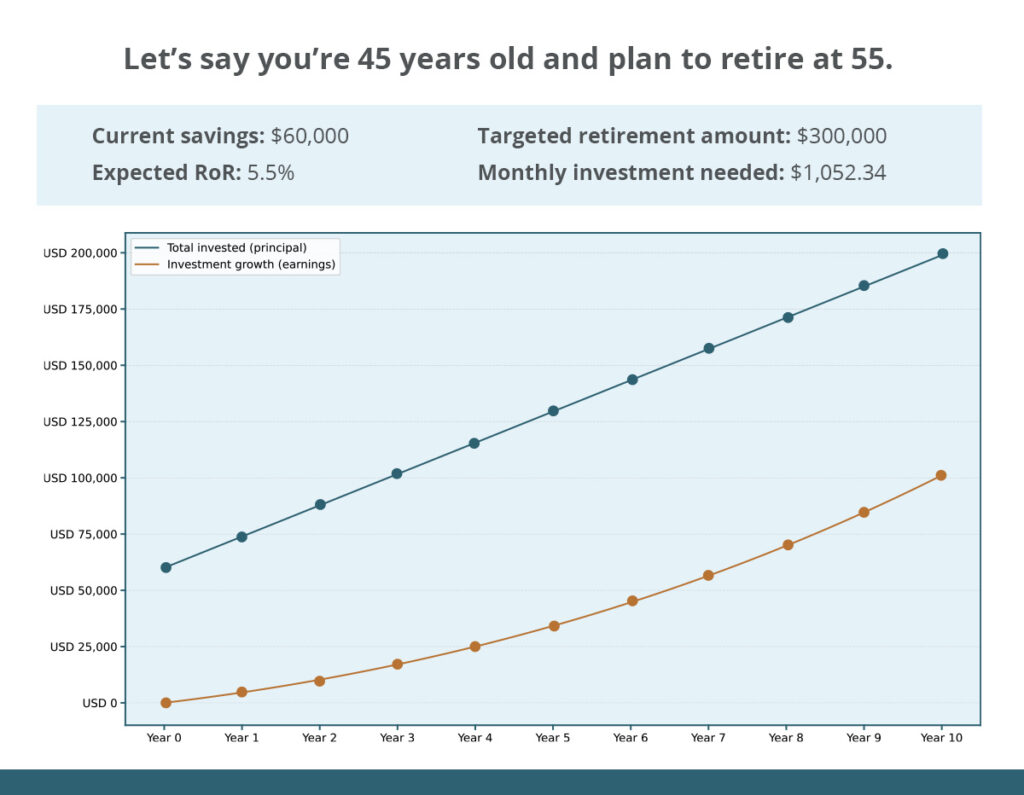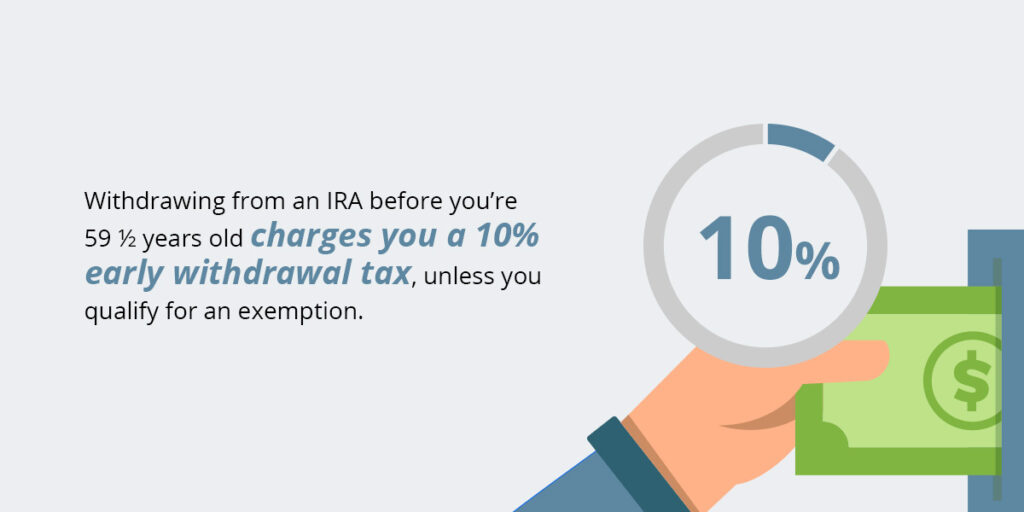
Early Retirement Calculator
Early Retirement Calculator
It’s exciting to think about early retirement and what you can do with all your spare time. However, computing the retirement savings you need isn’t always so simple. According to the National Council on Aging, 80% of older adults face financial challenges and are at risk of economic insecurity in retirement. Gallup shows a more positive study, where 3 in 4 retired Americans have enough money to live comfortably.
Retiring early may require more assets and tighter budgets. Financial planning helps you see if you’re on track and what adjustments you need to make otherwise. These early retirement strategies and calculator can serve as your guide on how to calculate savings for early retirement and optimize your investment strategies.
What You Need to Calculate Your Early Retirement Number
Monthly investment contributions can help you retire early. How much you should invest depends on the following:
- Current age
- Retirement age
- Current savings amount
- Expected rate of return (RoR) on investments
The RoR, or the growth rate, of your investments can be affected by market conditions and investment type. For reference, the 10-year return of the S&P 500 as of September 2025 is about 12%. The RoR may be higher or lower when you retire, but a diversified portfolio can mitigate risks.

To use the calculator, input the required information, including your targeted retirement savings. Let’s say you’re 45 years old and plan to retire at 55. If you currently have $60,000 in your savings, expect a 5.5% RoR, and have a targeted retirement amount of $300,000, you’d need to invest at least $1,052.34 monthly. By 55, you would have invested a total of $198,908.88, with $101,090.48 in earnings. Your estimated retirement savings would be $299,999.36.
Retirement Savings Calculator
Currency and Date Conventions
Cash flow forecast...
Charts
Help
Message
How Much Should You Save for Early Retirement?
The amount you need to live comfortably depends on your potential lifespan and lifestyle. According to the National Center for Health Statistics, the average person has a life expectancy of 78.4 years, particularly 75.8 years for men and 81.1 years for women.
Expenses can include housing costs and necessities, Social Security obligations, taxes, and health care expenses. Also, consider any travel plans or other similar expenses.
Inflation also plays a role. Based on historical averages, you can expect inflation increases of about 2% to 3%. According to the Bureau of Labor Statistics, the average annual consumer expenditure in 2023 was $77,280. Housing accounts for the largest share at 32.9%, followed by transportation at 17% and food at 12.9%.
Your income may increase each year depending on cost-of-living wage increases. This can lead to more savings and investment opportunities. An early retirement financial advisor can help you create a unique plan.
Retirement Withdrawal Rate
The 4% rule recommends withdrawing 4% of your retirement funds in the first year, adjusting annually for inflation. It aims to sustain your funds for about 30 years, with investment returns offering a steady income stream. Retiring early may require a more conservative approach. Depending on market conditions and your personal circumstances, 3% may be a safer withdrawal rate.
Because of the rule’s rigidity, it’s not always suitable for everyone. The rule covers the taxes and investment fees and assumes you spend similarly each year. You may also have more than a 30-year timeline if you retire early.
Investment Vehicles for Early Retirement
If your calculation shows that you need to invest more than you currently do, the following investment vehicles can help you:
- Traditional and Roth 401(k)
Traditional and Roth 401(k) plans offer tax advantages for your retirement savings. A traditional 401(k) is employer-sponsored and lets you contribute pre-tax dollars. You pay taxes on contributions and earnings upon withdrawal. Roth 401(k) lets you make after-tax contributions and withdraw earnings tax-free. Employers can match your contributions on both plans.
In 2025, individuals can contribute up to $23,500 to a 401(k) plan. Catch-up contributions for those over 50 are $7,500. Employees who are 60 to 63 years old get a higher catch-up contribution limit of $11,250.
When choosing a plan, consider the tax implications of your early retirement. To help you save more long-term, you may consider a backdoor Roth strategy. Although not applicable for all accounts, this strategy helps you bypass income and contribution limits by converting certain after-tax 401(k) contributions into a Roth 401(k) or a Roth IRA.
- Traditional and Roth IRAs
Traditional and Roth IRAs also help you save for retirement. Traditional IRA contributions are tax deductible, but withdrawals and earnings are taxed as regular income. You must take required minimum distributions the year after you turn 72 or 70 ½ if you turned this age before January 1, 2020. A Roth IRA lets you contribute at any age, but income limits apply. Your contributions are not tax deductible, but qualified distributions are tax-free. You’re also not required to take distributions at a specific age.

However, withdrawing from an IRA before you’re 59 ½ years old charges you a 10% early withdrawal tax, unless you qualify for an exemption. In 2025, the contribution limit for both accounts is $7,000. Catch-up contribution limit for people over 50 is $1,000.
A Roth conversion ladder is one of the early retirement strategies you can adopt. It moves money from your tax-deferred retirement accounts, like a traditional 401(k), into a Roth IRA over several years, helping you avoid early withdrawal penalties. Despite the IRA contribution limit, there’s no limit to Roth IRA conversions. You only need to wait five years for each conversion before you can withdraw the amount penalty-free.
- Health Savings Account
A health savings account (HSA) works with a high-deductible health plan (HDHP). It helps you save for qualified out-of-pocket expenses like medications, doctor fees, and dental procedures. This can help you significantly with health care costs during retirement.
The account offers triple-tax advantages, meaning you get:
- Tax-deductible contributions.
- Tax-deferred growth for your earnings.
- Tax-free withdrawals for qualified medical expenses.
- Taxable Brokerage Accounts
Taxable brokerage accounts let you invest in different assets like stocks, bonds, exchange-traded funds (ETFs), and mutual funds. There are no contribution limits or withdrawal penalties. The accounts can help you diversify your portfolio and save for different goals, such as purchasing a home or building your emergency fund. They can also supplement your retirement accounts if you’ve maxed out your tax-advantaged options.
- Real Estate Investment Trusts
Real estate investment trusts (REITs) let you invest in real estate without purchasing properties yourself. REITs are companies that operate income-producing properties, like office buildings and shopping malls, as part of their investment portfolio. When you invest in REITs, you can earn a share of the properties’ income, offering a passive income potential.
Why Trust Our Financial Advisors
Financial planning for early retirement is essential in achieving your goals. Our trusted financial advisors can help you out, having worked with clients since 1995. Our decades of experience can help you determine the investment strategy suitable for your needs. As a fiduciary advisor, we have your best interests at heart, having no conflicts of interest or product biases. We’re also big on transparency—charging no hidden fees and only offering recommendations that fit into your overall plan.
Get Matched With a Financial Advisor Today
Identifying ways to invest for early retirement works best with a trusted advisor. Our private wealth management services can help you create a plan based on your priorities, and our financial advisory services help you see your financial goals as a whole, preventing tunnel vision for certain investments. Whether you’re on track with your financial goals or need to make adjustments, we can develop a realistic and adaptable plan for you. Get matched with an advisor today.
Disclaimer: Kovitz Investment Group Partners, LLC D/B/A Fort Pitt Capital Group is an investment adviser registered with the Securities Exchange Commission under the Investment Advisers Act of 1940 that provides investment management services to individual and institutional clients. SEC registration does not constitute an endorsement of the firm by the Commission nor does it indicate that the adviser has attained a particular level of skill or ability.
The information included herein may contain statements related to future events or developments that may constitute forward-looking statements. These statements may be in the form of financial projections and may be identified by words such as “expectation,” “anticipate”, “could”, “estimate”, “will”, “should” or similar terms. Such statements are based on the current expectations and certain assumptions of the author and are, therefore, subject to certain risks and uncertainties. Fort Plitt Capital Group does not guarantee the timeliness, sequence, accuracy or completeness of information included.
Certain information contained in these materials has been obtained from published and non-published sources prepared by third parties, which, in certain cases, have not been updated through the date hereof. While such information is believed to be reliable, Fort Pitt Capital Group has not independently verified such information nor does it assume any responsibility for the accuracy or completeness of such information. Except as otherwise indicated herein, the information, opinions and estimates provided in this presentation are based on matters and information as they exist as of the date these materials have been prepared and not as of any future date, and will not be updated or otherwise revised to reflect information that is subsequently discovered or available, or for changes in circumstances occurring after the date hereof. Fort Pitt Capital Group’s opinions and estimates constitute Fort Pitt Capital Group’s judgment and should be regarded as indicative, preliminary and for illustrative purposes only.
Investment decisions should always be made based on the investor’s specific financial needs, goals and objectives, time horizon and risk tolerance. Accordingly, the information herein should not be relied on in making any investment decision, as an investment always carries with it the risk of loss and the vulnerability to changing economic, market or political conditions, including but not limited to changes in interest rates, issuer, market risk, credit and inflation risk, deflation risk, currency risk, foreign exchange rate risk, securities prices, market indexes, reinvestment risk, business risk, liquidity risk, financial risk, cybersecurity risk, operational or financial conditions of companies or other factors.
Past performance is not a guarantee of future results. The prior performance figures indicated herein represent performance for only a short time period and may not be indicative of the returns or volatility each investor will generate over a long time period. Performance should also be viewed in the context of the broad market and general economic conditions prevailing during the periods covered by the performance information. Any references to future returns/risk are not promises of the actual return the client portfolio may achieve. Before investing, investors should seek financial advice regarding the appropriateness of investing in any securities of investment strategies discussed. Not all investments are suitable for all investors.
The description of products, services, and performance results of Fort Pitt Capital Group contained herein is not an offering or a solicitation of any kind. Past performance is not an indication of future results. Securities investments are subject to risk and may lose value.
Our Locations
Join Our Newsletter
Receive updates from our blog, retirement plan industry events & news, media appearances, and the latest on Fort Pitt events.
Fort Pitt is now part of Kovitz. Click here to learn more.


